The Lakenvelder chicken is quite interesting. If you love active chickens, this is just the right breed for you.
What is the history of the breed? Why is the Lakenvelder an interesting chicken breed? Continue reading this article to learn awesome facts about the Lakenvelder breed.
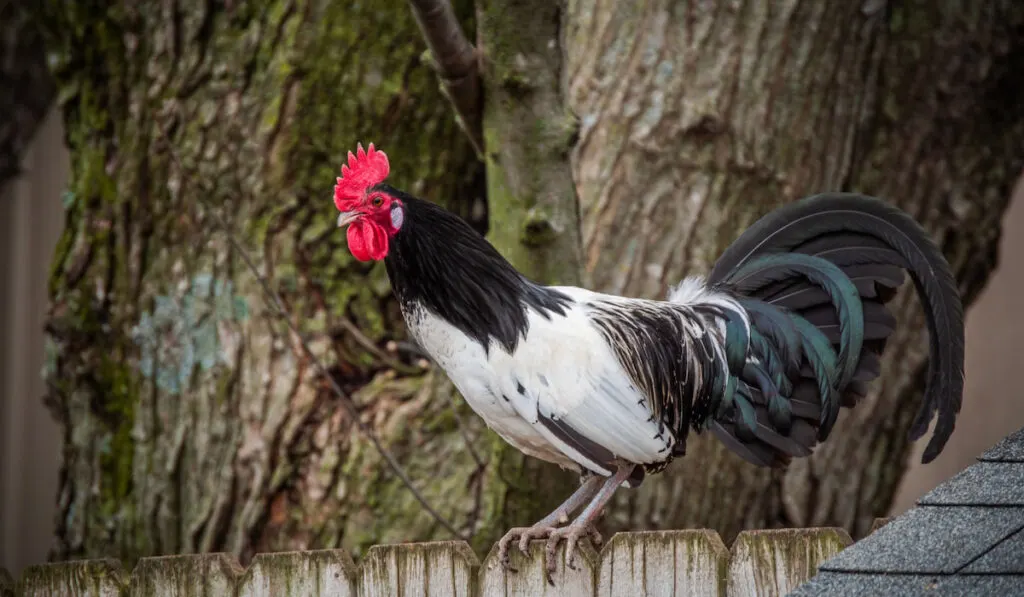
Table of Contents
History and Origin
The history of this beautiful breed was not properly documented. However, the chicken most likely originated from the southern regions of Holland around the borders of Germany early in the 1700s.
Lakenvelders were popular at the time until they eventually found their way to Great Britain around the early 1900s. It then found it’s way to the United States soon after.
In 1939, the American Poultry Association (APA) recognized Lakenvelder chickens.
Characteristics
Three features that easily identify Lakenvelder chickens are their size, color, and how active they are. Lakenvelders are small to medium-sized, colored black and white, and are very active.
These chickens are lovely, and you’ll appreciate them more when you get to know them better.
Size
When you compare the size of Lakenvelders with other chickens, you’ll agree that Lakenvelders are quite small. Lakenvelders often stand around a foot tall when mature.
As for the size, Lakenvelder chickens can weigh the following depending on their type:
- Cock: 5 lbs (2.3 kg)
- Hen: 4 lbs (1.8 kg)
- Bantam Cock: 1.5 lbs (0.7 kg)
- Bantam Hen: 1.25 lbs (0.5 kg)
Note that bantams are dwarf chickens. “Bantam Lakenvelders” simply means “dwarf Lakenvelders.”
Color
You’ll surely know Lakenvelder chickens by their colors. They have a combination of white and black feathers.
The hackles and tail feathers of Lakenvelder chickens are black while the middle of the body is covered in white feathers.
The tip of the feathers of Lakenvelder chicken wings are black. These chickens have red wattles, a single red comb, and white earlobes. The open parts of their legs are grayish blue.
Eggs
Lakenvelders can lay over 150 eggs per year. Their small to medium-sized eggs are white but sometimes come as tinted light brown.
Lifespan
If you are raising Lakenvelder chickens as pets or for other reasons that require you to keep them for a very long time, they can live for six to eight years.
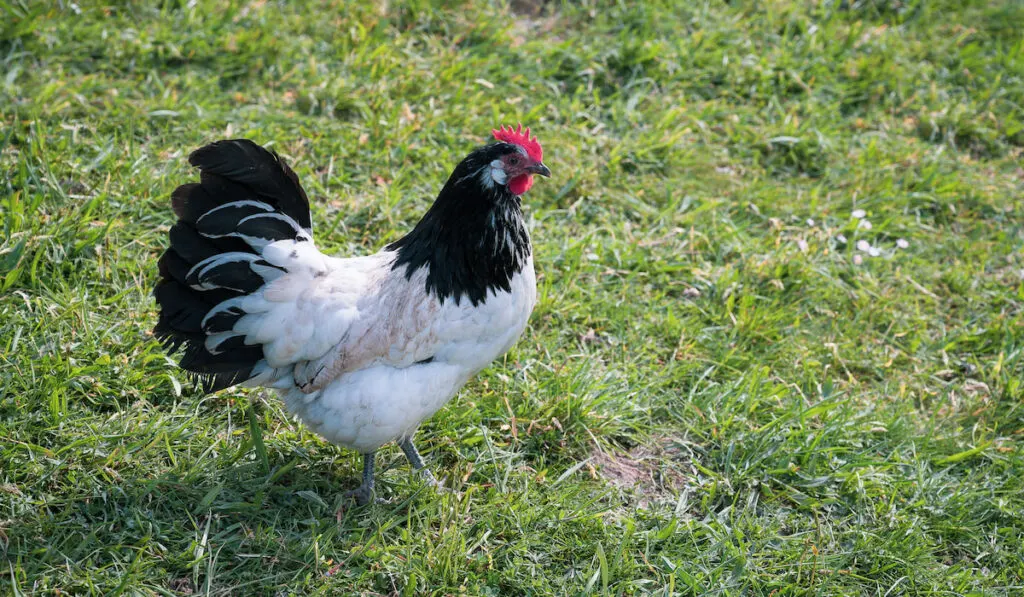
So long as their living conditions are optimal and you give them quality feed, they will live long.
Sexing
You can easily identify mature male and female chickens no matter the breed. As for young Lakenvelders, it’s not so easy to tell which is male or female.
Lakenvelder cockerels have a dominant stance, and their comb comes develops earlier than the females, so you can tell their sex by looking at them carefully after a few weeks.
As they grow older, you’ll know their sex by their sound and behavior.
Lakenvelder roosters are territorial just like the roosters of other breeds.
Behavior and Temperament
If you are looking for a very calm and docile breed, this isn’t the breed for you. Lakenvelders are very active, and they love open spaces.
Your chickens will only be happy if you raise them in a yard where they can forage with ease. Also, they love attempting to fly, so you will witness a lot of flying attempts in your yard when you raise them.
Lakenvelder hens are lazy mothers and are not broody. As such, you may see a lot of neglected chicks if you leave them with their mother.
Uses
Lakenvelders mostly have agricultural uses, as they are commonly raised for meat and egg production.
However, they are suitable to be used as ornamental birds because they are beautiful and will always give you a show to entertain you in your yard.
Meat Production
The most common use of Lakenvelder chickens is meat production. Lakenvelder meat may be smaller than that of other chickens, but they are quite tasty.
The meat does not crumble quickly while you eat it like the meat of other breeds, so people love Lakenvelder meat. This is why farmers continue to raise Lakenvelders even though there are larger breeds.
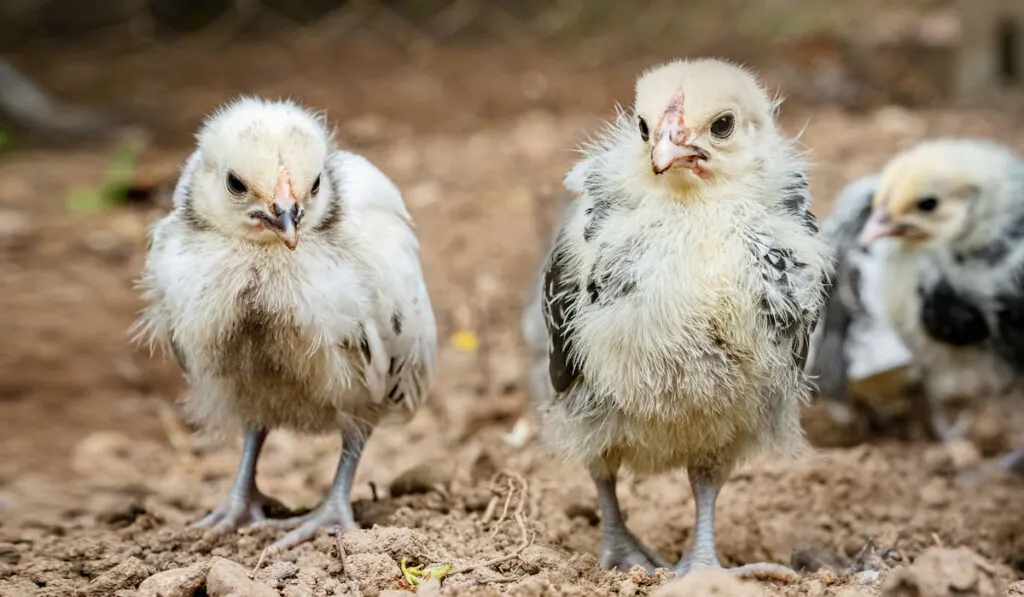
Egg Laying
Aside from meat production, people also raise Lakenvelders for their eggs.
The Lakenvelder hens start laying eggs at around week 22 and continue afterward.
If you want your Lakenvelder hens to lay eggs when winter comes, keep them in optimal conditions in winter. However, leaving them to rest during the winter is not a bad idea.
Ornamental or for Show
Some people keep Lakenvelder chickens in their yards just for entertainment. These chickens are hardy, and they are fun to watch, especially when they run in the yard or try to fly.
It is almost impossible to catch Lakenvelder chickens in a race because they run really fast, so try catching them for fun.
Some people also train their Lakenvelder chickens so that they can use them for chicken shows and other projects.
Hatching and Raising
You are not wrong if you think that Lakenvelder chickens are very easy to care for. So long as they are vaccinated and have access to quality feed and clean water, you can raise them without many worries.
However, note that these chickens do not make good mothers, so you will most likely brood Lakenvelder chicks on your own or employ a mother chicken from another breed.
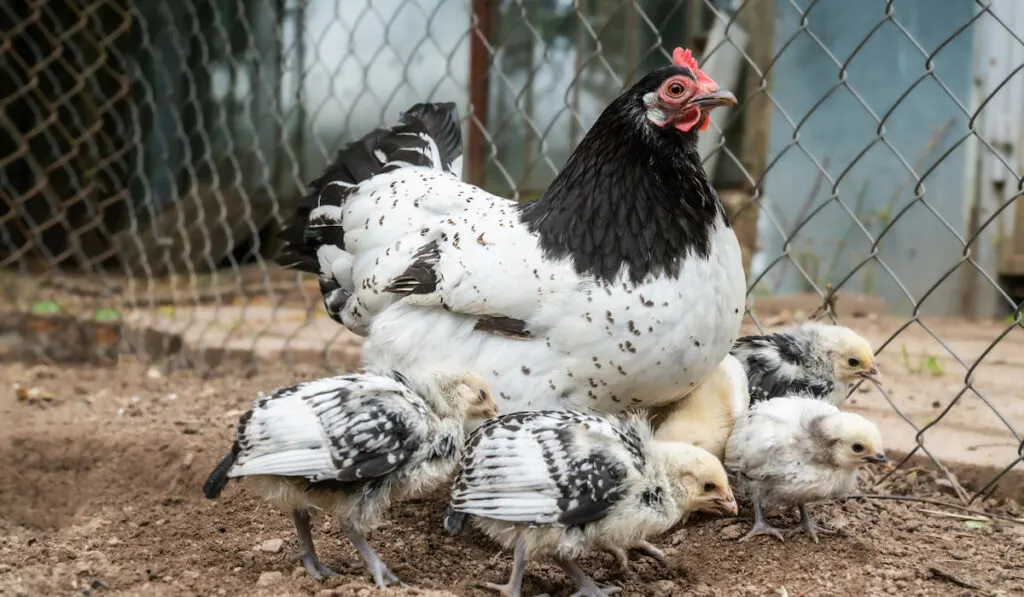
Incubation, Hatching, and Brooding
You can rely on your Lakenvelder hen to incubate her eggs because incubating eggs comes naturally to every chicken.
However, you can place the fertile Lakenvelder eggs near the eggs of another breed so that a more experienced hen can incubate the eggs and brood the chicks.
If you have no other breed and do not want your Lakenvelder hen to incubate her eggs, make use of an incubator.
It’s not a great idea to leave your Lakenvelder chicks with their Lakenvelder mom, because Lakenvelder moms are bad at brooding chicks.
Here are two options for you:
- Use a brooder box: You can care for the chicks at their tender age using a brooder box. When they are six weeks old (sometimes earlier), you can start training them to go outside.
- Employ another hen: This is only possible if you placed the eggs near the eggs of the other hen because the chicks may imprint on the hen and will follow her.
Just make sure that your Lakenvelder chicks get the ideal temperature and quality feed.
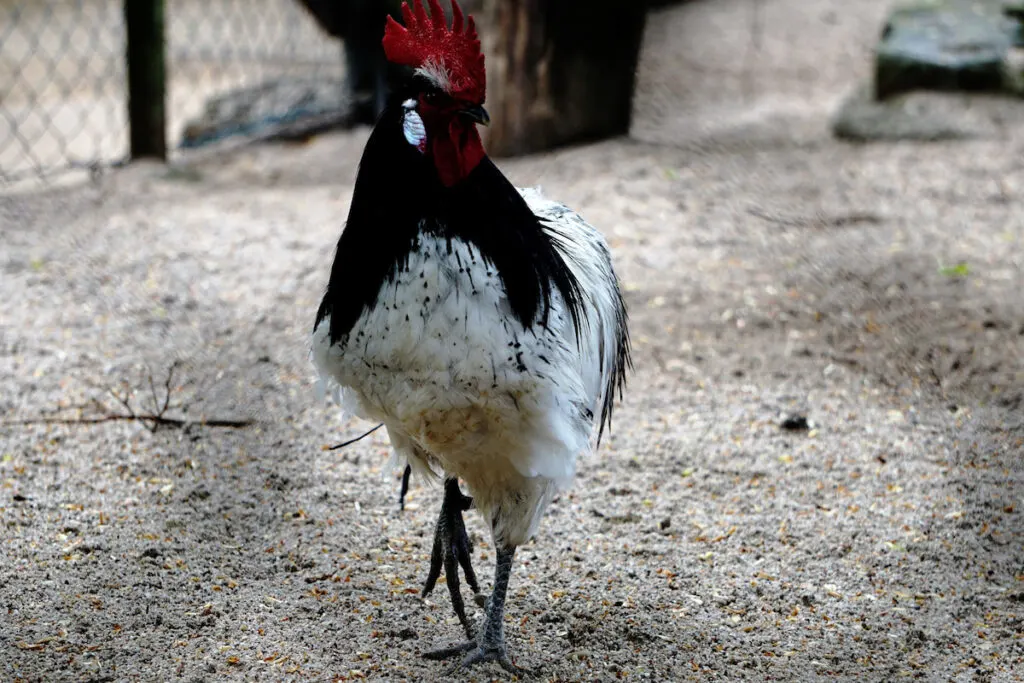
Housing
Lakenvelders are very active even in their coop, so a standard coop for the breed is 5 square feet per mature bird.
These birds love to go outside, so make sure that there are two or more doors so that no bird (usually a rooster) will stop others from going out.
Your yard should have a tall fence that can prevent the birds from going out because they love jumping and attempting to fly. A roosting area (around the coop) is important so that when your birds need to rest during the day, they can have a suitable spot.
When your birds are young, you can train them to return to their coop in the evening (around 5 pm) with treats. Reward the ones that return early. In time, they will learn to return to their coop.
Feeding
Feeding Lakenvelders is quite easy. So long as you have a mash or quality feed for them, you are good to go. Here are some tips to feed your birds:
- Keep some of the feed outside: These birds spend most of their time outdoors, so it’s a great idea to keep some (not all) of their feed outside. However, do not place the feed too far from their coops so that they do not go too far from the coops.
- Ensure that the feed is always clean: The feed should be clean and free from chicken poop. Also, if the feed gets wet due to rain or high humidity, dispose of it. Just make sure that your chickens eat fresh feed.
- Give your Lakenvelders more feed in dry or cold seasons: Lakenvelders love to forage and will most likely find a lot of food in the spring months. However, they may not find a lot of food in winter, so increase their ration when winter comes.
Some examples of quality feed for Lakenvelders are mash (formulated feed from feed mills), protein-rich seeds, grains, insect treats, fruit treats, etc.
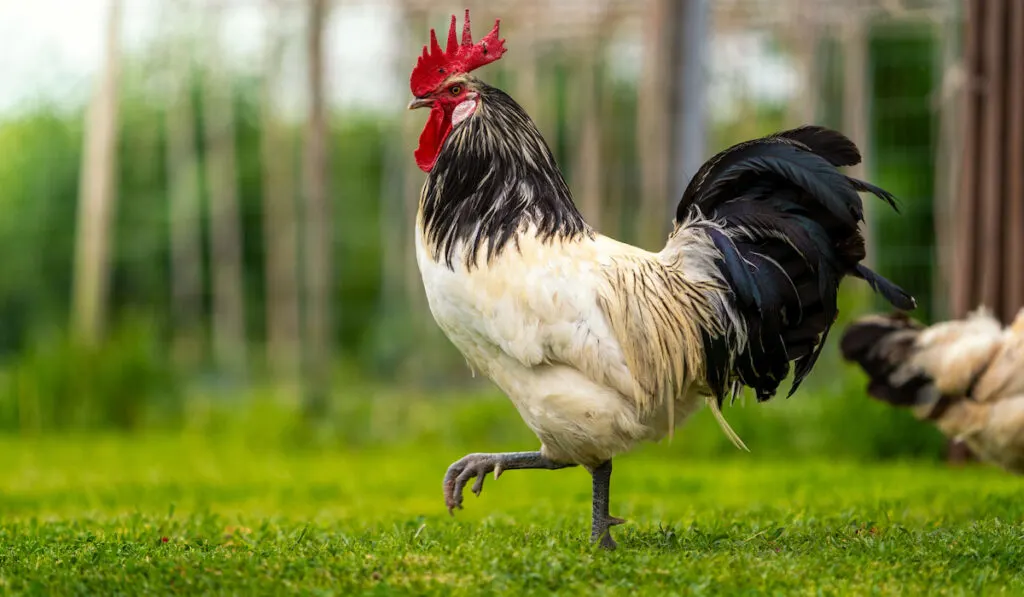
Free-Range Care
Your yard should be around 25 square feet per bird so that your Lakenvelders can have enough space to run, attempt to fly, and search for food. The yard should also be rich in vegetation or have nutrient-rich soil.
In a yard with nutrient-rich soil, your Lakenvelders will easily find food such as earthworms and insect larvae in the soil. In a yard with a lot of plants, your chickens will easily find fruits, seeds, insects, lizards, and other foods.
If there is no tall tree (with a canopy) in the yard, try to make a temporal shade so that your chickens can hide from the sun when it gets too hot.
The shade can also protect them from the rain if they do not want to go inside their coop.
Sometimes, check the yard at night for birds that do not return to their coop. Always bring those birds back to their coop until they learn to return to the coop and not stay outside.
Final Thoughts
The Lakenvelder is truly an interesting breed, and it would be an awesome addition to your yard. If you put in the work, your chickens will grow into healthy and active birds.
Make use of the tips in this article to raise healthy Lakenvelder chickens.
Resources
- https://breeds.okstate.edu/poultry/chickens/Lakenvelder-chickens.html?Forwarded=afs.okstate.edu/breeds/poultry/chickens/Lakenvelder/index.html/index.html
- https://livestockconservancy.org/heritage-breeds/heritage-breeds-list/Lakenvelder-chicken/
- https://backyardpoultry.iamcountryside.com/chickens-101/Lakenvelder-chicken/
- https://www.roysfarm.com/Lakenvelder-chicken/
- https://learnpoultry.com/Lakenvelder-chickens/
